|
|
Pueblo Treasures Museum Tour!
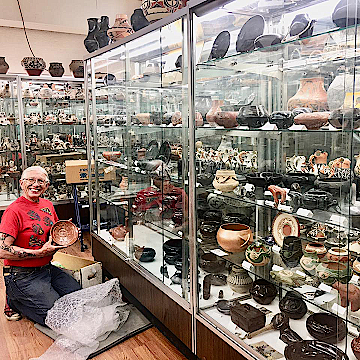
|
|
Sunday January 16, 2022
Among the many enthusiastic responses to my recent postings about my Pueblo Treasures Museum (located here in Denver) were several from people who wished to visit the gallery, and to be provided with a personal tour. That is fine by me, as long as people write to me in advance (chuckrozanski@gmail.com), as I am oftentimes out on the road, driving many thousands of miles around the nation to purchase old comic books and popular culture toys collections for my company, Mile High Comics.
Given that I can provide only limited windows of opportunity for personal tours, I decided yesterday that it would be both a kindness, and positive public service, for me to put together an online photo gallery of the 68 large showcases that I currently have filled with my Pueblo ceramics. Thankfully, my iPhone 12 has a new photo feature that allows me to now take a straight-on shot of each of my cases, even though our aisles are only 52 inches wide. I apologize for oftentimes having my own reflection appear in my photos, but that is the only option when dealing with straight-on shots of mirror-backed showcases.
As these first seven showcases (featuring approximately 1,000 beautiful sculptures from the Hopi villages) illustrate, I take the exact opposite approach to most public museums in that I provide our visitors with total access to my entire collection, without any pieces tucked away in a storage facility. The good news is that my policy of total display of all of my treasures creates a phenomenal visual feast, one that everyone who has visited thus far has told me that they truly love and appreciate.
The not-so-good news is that such a vast array of art is actually far too much for anyone (including myself) to analyze or appreciate in a short period of time. That has left almost all of my recent visitors who have been given tours of my Pueblo Treasures Museum joyfully bedazzled, but also feeling more than a little bit overwhelmed. Anyone planning a visit should understand in advance that even an entire hour’s walk-through provides you with only a scant 50 seconds of viewing time per each of my 68 showcases. Need I say more?
I would thus suggest that anyone planning a visit to first spend some time in advance looking at each of my 68 photos that I will be providing over the next two weeks, and to seek out specific items about which to ask questions. I love all of my pottery beyond all words, so I delight in expounding (at great length) about the history of each piece. In doing so, however, I use up even more of my visitor’s precious time. Sigh… Above all else, having a game plan created in advance should make your visit to my beautiful collection considerably more enjoyable and satisfying. I promise you that you will still leave unsated, but at least you will have gained in-depth knowledge about your favorites.
Tomorrow, I will post for you photos of my 5 showcases jam-packed with San Ildefonso ceramic treasures. I hope that my current photo project brings you some small measure of joy and happiness, especially during these dark days when so few of us can travel.
Love is love ❤️
|
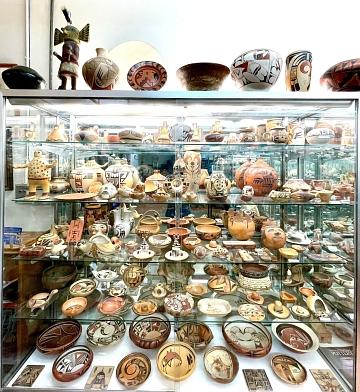
|
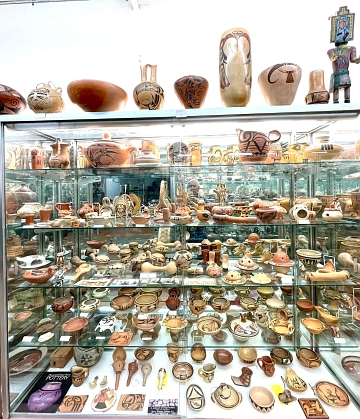
|
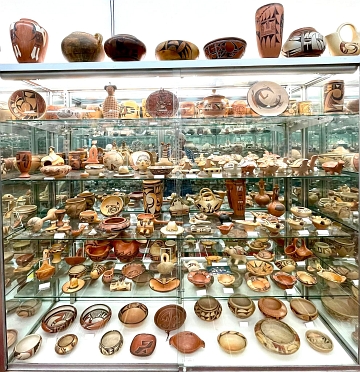
|
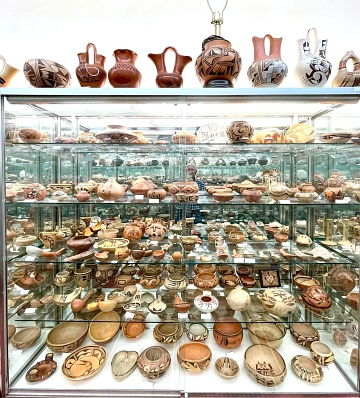
|
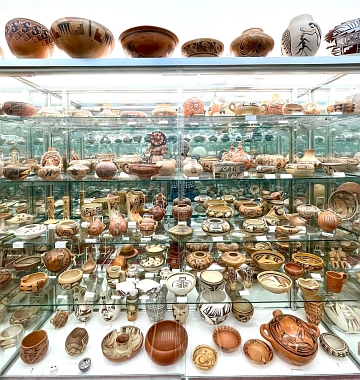
|
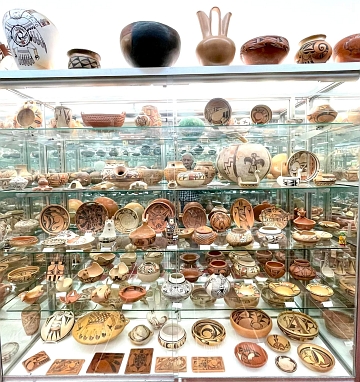
|
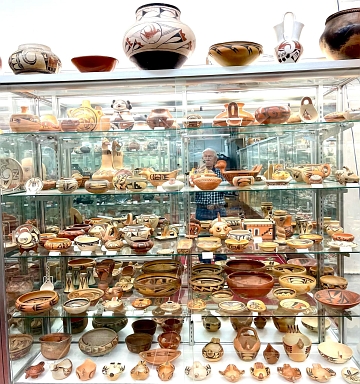
|
|
Monday January 17, 2022
My second installment of my online tour of my Pueblo Treasures Museum (located in Denver, Colorado) features five showcases that are jam-packed with 700-800 pieces of stunning artwork that was created by the residents of San Ildefonso Pueblo, which is located on the Rio Grande just north of Santa Fe. While San Ildefonso is most widely-recognized as the home of legendary creators Marie & Julian Martinez, I have chosen to build a representative ceramics survey of all the creators who lived (and currently live) in that beautiful village, with a special focus on polychrome (as opposed to blackware) creations.
Since almost everyone asks, yes, I do own about 20 Maria ceramics (including at least three lidded cornmeal boxes, and a lidded cylinder), but I am personally far more enamored of the ultra-rare polychrome creations produced during the late-1800’s by Marianita Roybal. That is why I am sharing individual images of the five of her works that I have been able to obtain for the museum at the end of the group photos.
That having been said, please note that the first Marianita piece shown, while once spectacular, is now significantly damaged, with a missing handle and the bird effigy’s upper beak having been lost. While those missing pieces greatly reduce it’s marketplace value, such economic diminishment matters to me not one whit, as I view the role of my museum to be expanding our understanding of a creator’s style evolution and proficiency, above all else. In a nutshell, that is why I have given a home in my museum to many chipped and cracked Pueblo ceramics, ones that more discriminating collectors would most likely reject. When pristine examples of creator’s works are available, I do most certainly seek to obtain them, but I will never reject a piece that expands our knowledge simply because it has a flaw.
Another bias that should be clearly evident in my photos of my cases is that I have relatively few examples of the beautiful turn-of-the-century polychrome ollas that defined a particularly significant peak in artistic expression at San Ildefonso. Frankly, prices on those beautiful jars have risen so high that I have deferred buying them in order to redirect my purchases into pieces that I believe to be equally significant, but less popular. My hope is that I can begin (slowly) adding some of those wonderful polychrome ollas into the museum collection this summer.
Finally, I want to highlight the wild and crazy ceramic imaginings of Gilbert Sanchez, Jr. that are predominate in case #5. Gilbert is a dear friend of mine, and I have sought to support his artistic efforts whenever my finances would allow. I have never counted, but I believe that I own upwards of 100 of his creations, with the remarkable Star Wars “Wookie” figure that he made for me (after my friend Eddie Naranjo’s unexpected passing in 2000) being particularly cherished. I will share images of some of Eddie’s beautiful Santa Clara Pueblo Star Wars figures with you when we reach my 18 Santa Clara cases, later in this online tour.
Love is love ❤️
|

|

|

|

|

|

|

|
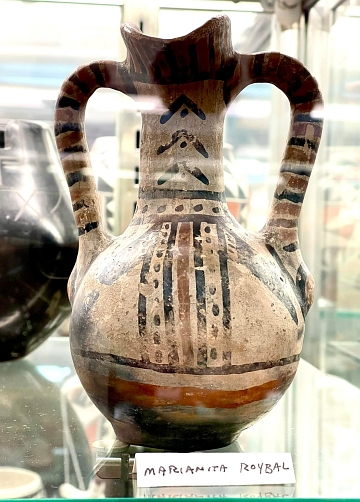
|
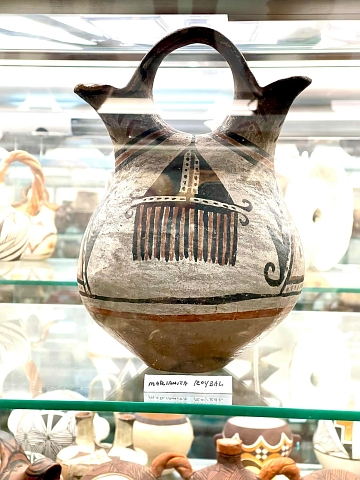
|
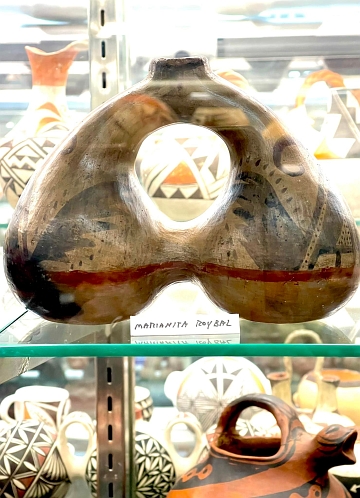
|
|
Tuesday January 18, 2022
As those of you who have perused my first two showcase arrays (consisting of photos of my vast Hopi and San Ildefonso Pueblo pottery collections) may have already surmised, my Pueblo Treasures Museum is quite dissimilar from what you will find on display in most public institutions. My personal experience has been that the majority of public museums exhibit just a few monumental objects by well-known creators, with an oft-times stated goal of somehow validating Pueblo ceramics as “fine art.”
While I applaud those efforts of providing some minimalist degree of education about Pueblo art to a large number of people, those public displays are (of necessity) only quick sound bites about Pueblo art and culture, presented in truly cursory fashion to those who otherwise have little in the way of knowledge.
My vision that I keep in mind while building my Pueblo Treasures Museum is quite the opposite. My goal is to provide my very limited number of pre-educated visitors with an immersive experience into a visual feast that illustrates the timelines of the evolution of ceramics production at each of the Pueblos for the past 1,000 years. Ironically, I frequently am aided in achieving my goal by acquiring cast-offs from public institutions (both modern creations, and ancient artifacts) that they have deemed insignificant and unimportant. By combining these “orphaned” pots into family and/or genre groups, I find that I can then birth visual synergies that are both profoundly beautiful, and oftentimes totally unique.
As regards my 5 cases illustrated today that are jam-packed with 800+ ceramics from Acoma Pueblo (I have hundreds of additional Acoma ceramics in my “genre” showcases), they give total credence to the premise that my museum that I am building is actually a blending of fine art, and folk art. Were I so inclined, I could easily have filled these five cases with stunningly beautiful large ollas, as many of the amazing artists at Acoma excel at creating their exquisitely formed and painted water jars. I have left displaying that more recognizable and cherished type of art to others, however, and have chosen to instead focus my Pueblo Treasures collection on displaying the amazingly whimsical and diverse pottery forms that the Acoma people have created over the past 150 years, typically to market to tourists.
While disdained by many purists, I believe that these pieces also have an important story to tell, both about the amazing capacity of the Acoma creators for unique aesthetic imaginings, and also about the necessities of economic survival during times of dreadful social oppression. Simply put, large water jars could not fit in the suitcases of tourists, but little bird dishes and salt & pepper sets were the perfect size for visitors to impulse purchase, and then to safely transport home. Those thousands of seemingly insignificant pottery sales helped many a family to survive the hard times, and I thus think that they deserve to be remembered (and truly cherished) as a gift given by Mother Earth to the Acoma people.
To my way of thinking, the stories and context behind the creation of an object of art are profoundly more important than any form of social appreciation for the surviving aesthetic. Tomorrow, I will share with you photos of my art from Zia and Ohkay Owinge Pueblos.
Love is love ❤️
|

|

|

|

|

|
|
Wednesday January 19, 2022
Today’s fourth installment in my series of photos of my Pueblo pottery showcases features two cases filled with about 200 hand-built ceramics from Sia (Zia) Pueblo and three cases filled with about 300 treasures from Ohkay Owinge (San Juan) Pueblo.
A question that may arise in the minds of those who have viewed my earlier posts about my vast Hopi, San Ildefonso, and Acoma collections is why I currently own significantly fewer items made by creators from these two equally-talented Pueblos. The easiest explanation is the limitation of my funding. As much as I love the creations from these two wonderful villages, my finances only allow me to make occasional purchases.
That easy (but simplistic) answer obscures the fact that I also resist buying traditional ollas, vases, and bowls from almost all of the Pueblos, as those truly do not interest me unless they have some kind of non-traditional embellishment. I am far more enamored of unusual forms, with a special interest in sculpted figures of all kinds, and all manner of pieces that were created (primarily) for tourists. Quite frankly, those kinds of artworks are harder to find from Sia and Ohkay Owinge, so the number of my purchases from those two Pueblos has (thus far) been limited.
The good news is that the pieces in my genres that I have located to this point from Sia and Ohkay Owinge are exceptionally fun, and their total number is now also growing rather rapidly as my finances gradually improve. I am especially happy with my assemblage of little clay Sia houses, fireplaces, and hornos. These architectural constructs are actually far harder to obtain than even those most ancient and revered Sia water jars that traditional museums hold in such high esteem. Strange, but true.
A final point about my photos from today is that the top shelves do not entirely consist of artworks from these two Pueblos. I am building my Pueblo Treasures Museum entirely on my own (and paying for all improvements and additions out of my own pocket) so my progress is oftentimes excruciatingly slow. Four years into rebuilding (after closing down my original gallery on 56th Ave. in 2017), I still have about 2,000 of my pieces left to unpack, and 15 showcases which still need missing parts restored, and a thorough cleaning. In the meantime, I oftentimes have no choice but to stash random items on top shelves until I can find them their permanent home.
Love is love ❤️
|

|

|

|

|

|
|
Friday January 21, 2022
For my fifth stop on my photo tour of my Pueblo Treasures Museum, I am going to change things up a bit, as the four showcases featured today contain only Pueblo owls. Two showcases are filled with Zuni owls, one (very large) showcase is overflowing with Acoma owls, and the final contains a combined flock of owls representing several other Pueblos (as well as a couple of prehistoric and replica owls). It is important to note that all of these owls are positioned at the front of my gallery quite intentionally, to act as my guardians.
That protection by my 400+ owls proved prescient last summer, when I became extremely ill with an upper respiratory ailment that inflicted upon me a fever of 102+. Rather than potentially infecting my beloved wife with what we thought might be COVID (it wasn’t…), I decided it best to sleep that night in my back room of my gallery that evening.
I was so sick when I arrived that night at our Jason St. Mega-Store, however, that I failed to notice (after I staggered inside) that I had not latched the front door of the building properly. This led to thieves walking in at 4 AM, and stealing an entire carload of collectibles from our downstairs comic book store, all while I was upstairs totally incapacitated by a fever-induced delirium. Our security cameras revealed that one of the thieves did also walk up the stairs to my pottery gallery. He opened the main door (where my owls were waiting), but then immediately turned right around and left without disturbing any of my pots, or attacking me while I slept.
To be clear, I absolutely credit my wonderful flock of owls for my having made it through that potentially deadly encounter, totally unharmed. As I view these things, you simply cannot ask for fiercer guardians.
Love is love ❤️
|

|

|

|

|
|
Saturday January 22, 2022
My sixth array of showcases filled with pottery pieces that are located in my Pueblo Treasures Museum is focused upon groupings that I have chosen to display by family. The first two cases feature pottery by Sara Fina Tafoya and her children, with a special emphasis on the amazing polychrome ceramics decorated by Sara Fina’s son, Manuel Tafoya, and the world-renown blackware made by her daughter, Margaret Tafoya.
Cases three and four are filled with Gutierrez family pottery, which consist primarily of stunningly beautiful polychromes. Case #3 features an amazing comic book-themed jar by Jason Garcia, a dear friend, and my single favorite creator currently working at Santa Clara. In case #4, I display over 100 polychromes painted with an incredible diversity of clay slips by Jason’s great-uncle (?),Van Gutierrez.
Case #5 contains a nice spectrum of animal figures by Jane Baca and Starr Tafoya, as well as my fearsome armada of Pueblo canoes. The central diorama was sculpted by Jane Baca, but then embellished with commercial paint by her sister, the world-famous painter, Pablita Verlarde.
Please note that the pieces on top of each case are random, and do not (yet) have any connection to the interior contents. My gallery is a work in progress, with more enhancements being implemented every week…
Love is love ❤️
|

|

|

|

|

|
|
Monday January 24, 2022
Today’s seventh installment of my 2022 Pueblo Treasures Museum online photo tour features five showcases within which I have constructed displays focused upon specific genres, with many of the represented artworks originally created specifically for sale to visiting tourists. The first case features a couple of hundred salt & pepper shakers on the upper levels, and on the bottom shelf (mostly) Santa Clara Pueblo ashtrays and candy dishes.
The next two showcases are focused on different iterations of lidded boxes and cylinders, many of which are quite rare. The bottom shelves hold even more candy dishes and ashtrays.The large wooden box with the sun face inlay may possibly have been made at Zuni high school, perhaps sometime in the 1950’s or 1960’s. Even though it is not ceramic, I hold it in particularly high esteem.
The final two showcases highlight my extensive collection of early (late-1800’s and up) candleholders from various Pueblos, and my beautiful flock of Santa Clara bird dishes.
Love is love ❤️
|

|

|

|

|

|
|
Sunday January 30, 2022
My ninth stop on my online tour of the Pueblo Treasures Museum showcases features a wide spectrum of creations from Tesuque and Jemez Pueblos. My collection of rain gods (of various types and iterations) consists of nearly 300 individual mono figures, derived from about a dozen Pueblos. The vast majority, however, were created at either Tesuque, or Jemez.
As is clearly evident from my photos, some artists at both of those Pueblos chose to utilize commercial pigments (rather than native clay slips) to decorate their pottery. This practice of using store-bought dyes, acrylics, and water color-based poster paints, was universally derided for many years by collectors and museum directors, but continued for the very compelling reason that these more colorful works sold very well to tourists.
To be completely candid, it is my personal belief that my non-traditional pieces in my collection are not only quite legitimate as Pueblo art, but that they also speak eloquently of an underlying need for adaptation to the horrific socio-economic oppression against the Pueblo people that existed throughout the early and mid-1900’s. With poverty, alcohol addiction, and a lack of employment plaguing many Pueblo families, I believe that these little potteries oftentimes provided desperately-needed cash for critical necessities.
Racial oppression (and the resulting poverty) are not considerations to which most pottery collectors (or even some Pueblo people) willingly speak, but the reality was that forced assimilation of the Pueblo people was the official policy of the United States government well into the 1960’s. Truthfully, (and I stress that this is only through my own personal lens) I see these colorful little pottery creations as passive acts of resistance against an oppressive regime that was aggressively seeking to destroy Pueblo culture. Not in the sense that they were created with even the slightest bit of negative intent, but rather that the small increments of funding that they provided helped some people to remain within their traditional villages. As such, they represent far more to me than just the “tourist trash” to which they have so frequently been ascribed. Just some food for thought…
Finally, please note that I have (to this point) only unpacked about 50% of my numerous pottery pieces from Jemez. I am building my Pueblo Treasures Museum entirely on my own, and fund all pottery purchases and museum improvements out of my own pocket. Progress is thus slow, but also quite steady. Four years after boxing up my original gallery on 56th Ave., I still have about 2,000 pieces (out of 10,000+) to unpack. Before I can unpack any further, however, I first need to pay for about $5,000 in showcase refurbishment and restoration costs, as there are over a dozen missing doors, and quite a few shelves that need replacing in my remaining cabinets. Please note, however, that I do already have those funds budgeted for in the upcoming 2nd quarter of the year, so no assistance is being requested. Slowly, but surely, my labor of love will continue.
Love is love ❤️
|

|

|

|

|

|
Privacy Policy: Mile High Comics, Inc. does not share any of your information with anyone.
Captain Woodchuck and all data © 1997-2020
Mile High Comics, Inc.TM All Rights Reserved.
Mile High Comics is a registered trademark of Mile High Comics, Inc.TM.All Rights Reserved.
All scans are exclusive property of Mile High Comics, Inc.TM and
may not be used on other websites without prior authorization.
For permission please contact Lynne MacAfee at
lynne@milehighcomics.com.
Denver CO 80211, USA
|























































